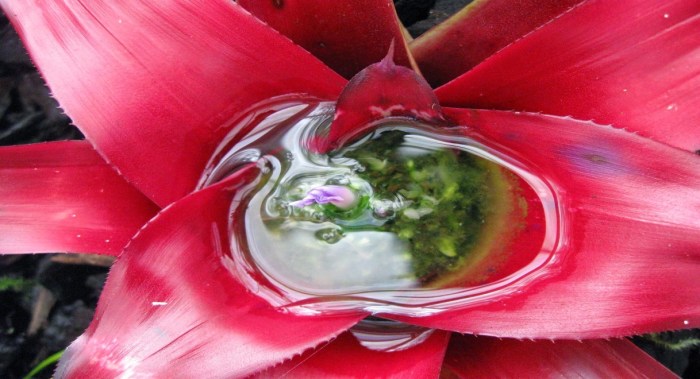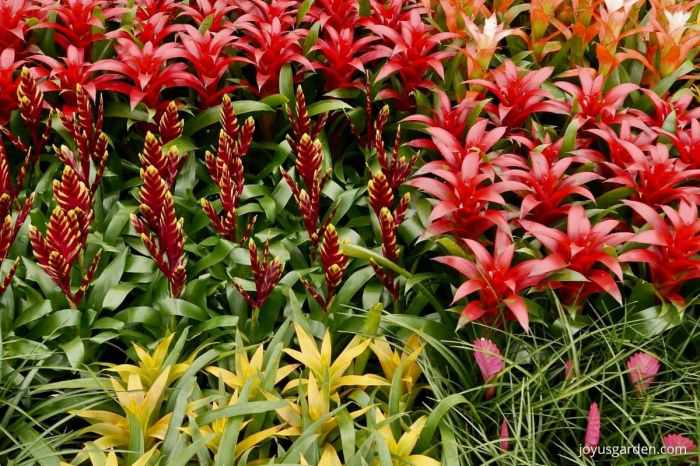How to Water a Bromeliad Plant
Understanding Bromeliad Watering Needs
How to water a bromeliad plant – Bromeliads, with their striking foliage and unique growth habits, require a watering approach different from most houseplants. Their water needs are influenced by several factors, ensuring proper hydration is crucial for their health and vibrant appearance.
Bromeliad Water Requirements Compared to Other Houseplants
Unlike many houseplants that absorb water primarily through their roots, bromeliads absorb water through both their roots and their central cup (also known as the tank or urn). This central cup collects rainwater in their natural habitat, providing a reservoir of moisture. Overwatering the soil is more detrimental to bromeliads than underwatering because their roots are susceptible to rot.
Factors Influencing Watering Frequency

Source: plantcaretoday.com
Several environmental factors determine how often you need to water your bromeliad. Pot size, climate, and season all play significant roles.
- Pot Size: Smaller pots dry out faster than larger ones, requiring more frequent watering.
- Climate: Hot, dry climates necessitate more frequent watering than cooler, more humid environments.
- Season: Bromeliads need more frequent watering during the active growing season (spring and summer) compared to their dormancy period (fall and winter).
Watering Needs for Different Bromeliad Varieties
Watering frequency and methods can vary slightly depending on the specific bromeliad variety. The following table provides a general guideline.
| Variety | Watering Frequency | Soil Moisture Preference | Leaf Watering Needs |
|---|---|---|---|
| Neoregelia | Water when the top inch of soil is dry | Slightly moist | Regularly fill the central cup |
| Guzmania | Water when the top inch of soil is dry | Evenly moist, but not soggy | Keep the central cup filled |
| Aechmea | Water slightly less frequently than Neoregelia or Guzmania | Slightly dry between waterings | Fill the central cup, allowing it to dry slightly between waterings |
| Billbergia | Water when the top inch of soil is dry | Well-draining soil | Fill the central cup less frequently than other varieties |
Proper Watering Techniques
Correct watering techniques are essential to maintain a healthy bromeliad. This section details the best practices for providing your plant with the right amount of water.
Watering the Central Cup
The central cup of a bromeliad should be regularly filled with water. Use filtered or rainwater; avoid using tap water that contains high levels of chlorine or fluoride, as these can harm the plant. Allow the water to sit in the cup for a few hours before discarding any excess. Repeat this process as needed, ensuring the cup doesn’t remain constantly full to prevent rot.
Using Filtered or Rainwater
Filtered or rainwater is preferable to tap water because it lacks the minerals and chemicals that can build up in the central cup and damage the plant. If you use tap water, let it sit out overnight to allow the chlorine to dissipate.
Bottom Watering Bromeliads
Bottom watering involves placing the pot in a tray of water for about 30 minutes, allowing the soil to absorb moisture from the bottom. This method is beneficial because it ensures the soil is evenly moistened without overwatering the central cup or causing root rot.
Watering the Soil Correctly
When watering the soil, avoid overwatering. Water thoroughly until water drains from the drainage holes, but do not let the plant sit in standing water. Allow the top inch of soil to dry out before watering again.
Identifying Signs of Overwatering and Underwater: How To Water A Bromeliad Plant
Recognizing the signs of overwatering and underwatering is crucial for maintaining the health of your bromeliad. Early detection allows for prompt corrective action.
Visual Symptoms of Overwatering
Overwatering leads to root rot and other issues. Visual symptoms include:
- Yellowing or browning leaf tips
- Soft, mushy leaves
- A foul odor emanating from the soil
- Leaves falling off easily
Visual Cues Indicating Underwater
Underwatering causes the plant to dry out, leading to:
- Wilting leaves
- Dry, brittle soil
- Crisp, brown leaf edges
- Overall dull appearance
Reviving an Overwatered Bromeliad
If you suspect overwatering, remove the plant from its pot, inspect the roots, and trim away any mushy or rotten sections. Repot the plant in fresh, well-draining potting mix and reduce watering frequency. Allow the soil to dry completely between waterings.
Addressing Underwater in Bromeliads
To address underwatering, thoroughly water the plant, ensuring the soil is evenly moist. Continue to water regularly, monitoring the soil moisture to prevent recurrence.
Watering Bromeliads in Different Environments
Watering strategies need adjustments depending on the environment in which your bromeliad is grown. Indoor and outdoor plants, as well as seasonal and light variations, affect water requirements.
Watering Strategies for Indoor vs. Outdoor Bromeliads
Indoor bromeliads generally require less frequent watering than outdoor plants due to lower evaporation rates. Outdoor bromeliads, especially in sunny locations, may need more frequent watering, particularly during hot and dry periods. Monitor the soil moisture regularly.
Watering Needs During Different Seasons
Bromeliads require more frequent watering during the spring and summer growing seasons when they are actively growing. Watering frequency should be reduced during the fall and winter months when growth slows down.
Watering Schedule for Various Light Conditions

Source: org.au
Plants in bright, indirect light may require more frequent watering due to increased evaporation. Bromeliads in low-light conditions may need less frequent watering.
Watering Adjustments Based on Environment
| Environment | Season | Light Condition | Watering Adjustments |
|---|---|---|---|
| Indoor | Summer | Bright, indirect | Water when the top inch of soil is dry |
| Indoor | Winter | Low | Water less frequently |
| Outdoor | Summer | Full sun | Water more frequently |
| Outdoor | Winter | Partial shade | Water less frequently |
Maintaining Soil Moisture and Drainage
Maintaining the ideal soil moisture level and ensuring proper drainage are vital for healthy bromeliad growth. This section details the importance of these factors and how to achieve them.
Ideal Soil Moisture Level, How to water a bromeliad plant
The ideal soil moisture level for bromeliads is evenly moist, but not soggy. Allow the top inch of soil to dry out between waterings to prevent root rot.
Importance of Well-Draining Potting Mix
A well-draining potting mix is essential to prevent waterlogging, which can lead to root rot. The mix should allow excess water to drain freely.
Creating a Suitable Potting Mix
A suitable potting mix for bromeliads can be created by combining equal parts peat moss, perlite, and orchid bark. This mixture provides good drainage and aeration.
Using Appropriate Containers

Source: joyusgarden.com
Use pots with drainage holes to prevent water from accumulating at the bottom. Terracotta pots are ideal because they allow for better air circulation and evaporation.
Visual Guide to Watering Bromeliads
Observing the visual cues of your bromeliad is crucial in determining its hydration status. This section describes the appearance of healthy, underwatered, and overwatered plants.
Healthy, Well-Watered Bromeliad
A healthy, well-watered bromeliad exhibits firm, upright leaves with a vibrant, consistent color. The leaves are plump and have a glossy sheen. The central cup may contain a small amount of water.
Underwatered Bromeliad
An underwatered bromeliad displays wilted, drooping leaves that may appear dry and brittle. The leaves may curl inwards and have brown, crispy edges. The soil will be dry to the touch.
Overwatered Bromeliad
An overwatered bromeliad shows soft, mushy leaves that may be yellowing or browning. The leaves may fall off easily. The stem might appear soft and discolored. The soil will be constantly wet and may have a foul odor.
Helpful Answers
Can I use tap water to water my bromeliad?
It’s best to avoid tap water, as chlorine and fluoride can harm bromeliads. Use filtered water, rainwater, or distilled water instead.
How often should I fertilize my bromeliad?
Fertilize sparingly, only during the growing season (spring and summer), using a diluted, balanced liquid fertilizer.
Watering a bromeliad involves filling its central cup and occasionally moistening the soil. The frequency depends on factors like sunlight and pot size; however, understanding proper watering techniques extends to other plants as well. For instance, knowing how often to water tomato plant helps illustrate the importance of considering environmental factors. Returning to bromeliads, avoid overwatering, which can lead to root rot, and ensure good drainage.
My bromeliad’s leaves are turning brown. What should I do?
Brown leaves can indicate overwatering, underwatering, or sunscald. Check the soil moisture and adjust watering accordingly. Relocate the plant if it’s in direct sunlight.
How do I repot my bromeliad?
Repot only when necessary, using a well-draining potting mix. Handle the plant carefully to avoid damaging its roots.




















